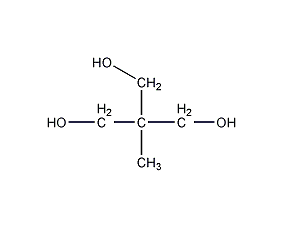Trihydroxymethylethane 2-Hydroxymethyl-2-methyl-1,3-propanediol


Structural formula
| Business number | 01MA |
|---|---|
| Molecular formula | C5H12O3 |
| Molecular weight | 120.15 |
| label |
2-Hydroxymethyl-2-methyl-1,3-propanediol, 1,1,1-Trihydroxymethylethane, 1,1,1-trihydroxyethylethane, Pentoglycerin, 1,1,1-Tris(hydroxymethyl)ethane, Trimethylolethane, Ethylidynetrimethanol, CH3C(CH2OH)3:Methyltrimethanolmethane, 2-(Hydroxymethyl)-2-methyl-1,3-propanediol |
Numbering system
CAS number:77-85-0
MDL number:MFCD00004687
EINECS number:201-063-9
RTECS number:TY7137500
BRN number:1304452
PubChem number:24889848
Physical property data
1. Properties: Odorless, free-flowing, white crystalline solid.
2. The standard heat of combustion (enthalpy) of the crystal phase (kJ·mol-1): -2938.0
3. The standard claim heat of the crystal phase ( Enthalpy) (kJ·mol-1): -744.6
4. Melting point (ºC): 204℃
5. Boiling point (ºC, normal pressure ): 13615
6. Boiling point (ºC, 5.2kPa): Uncertain
7. Refractive index: Uncertain
8. Flash point (ºC): 160℃
9. Specific rotation (º): Uncertain
10. Autoignition point or ignition temperature (ºC): Uncertain
11. Vapor pressure (kPa, 25ºC): Uncertain
12. Saturated vapor pressure (kPa, 60ºC): Uncertain
13. Heat of combustion (KJ/mol): Uncertain
14. Critical temperature (ºC): Uncertain
15. Critical pressure (KPa): Uncertain
16 . The logarithmic value of the oil-water (octanol/water) partition coefficient: Uncertain
17. Explosion upper limit (%, V/V): Uncertain
18. Explosion lower limit (% ,V/V): Uncertain
19. Solubility: Solubility [g / 100g solvent] (25℃): water 140, methanol 75.2, ethanol 27.9
Toxicological data
None yet
Ecological data
None yet
Molecular structure data
1. Molar refractive index: 29.78
2. Molar volume (cm3/mol): 103.6
3. Isotonic specific volume (90.2K ): 276.3
4.Surface tension (dyne/cm): 50.5
5, Polarizability (10-24cm3): 11.80
Compute chemical data
1. Reference value for hydrophobic parameter calculation (XlogP): -1.2
2. Number of hydrogen bond donors: 3
3. Number of hydrogen bond acceptors: 3
p>
4. Number of rotatable chemical bonds: 3
5. Number of tautomers: none
6. Topological molecule polar surface area 60.7
7. Number of heavy atoms: 8
8. Surface charge: 0
9. Complexity: 50.4
10. Number of isotope atoms: 0
11. Determine the number of atomic stereocenters: 0
12. Uncertain number of atomic stereocenters: 0
13. Determine the number of chemical bond stereocenters: 0
14. Number of uncertain chemical bond stereocenters: 0
15. Number of covalent bond units: 1
Properties and stability
None yet
Storage method
Strong stability and can be stored at room temperature.
Synthesis method
There are two main preparation processes: condensation disproportionation method and condensation hydrogenation method. Although the condensation disproportionation process is carried out in two steps, the reaction is carried out continuously in the same reaction device, so it is also called a one-step process.
The reaction of the condensation disproportionation method is as follows:
The first step: the product of the aldol condensation reaction of formaldehyde and n-propionaldehyde is 2,2-dimethylolpropionaldehyde;
The second step: Cannizzaro reaction between 2,2-dimethylolpropionaldehyde and formaldehyde.
Through the above two-step reaction, the target product TME is obtained, and formate is produced as a by-product. The TME yield reaches 90% (calculated as propionaldehyde), and the TME yield after extraction is >70%,
Content ≥97%.
Purpose
It has properties such as light resistance, heat resistance, hydrolysis resistance, antioxidant, and chemical resistance, as well as super weather resistance, stability and gloss. It is mainly used as raw material for alkyd resin, polyurethane resin and high-grade paints and coatings. It is used as heat storage material and can also be used to prepare plasticizers and surfactants. Advanced lubricants, liquid fuel additives, reactive diluents, synthetic leather and insulation materials. TME has a higher hardness than TMP, so it is more suitable for the production of alkyd resin, high solid resin, powder coating resin, polyester and reducing resin.
